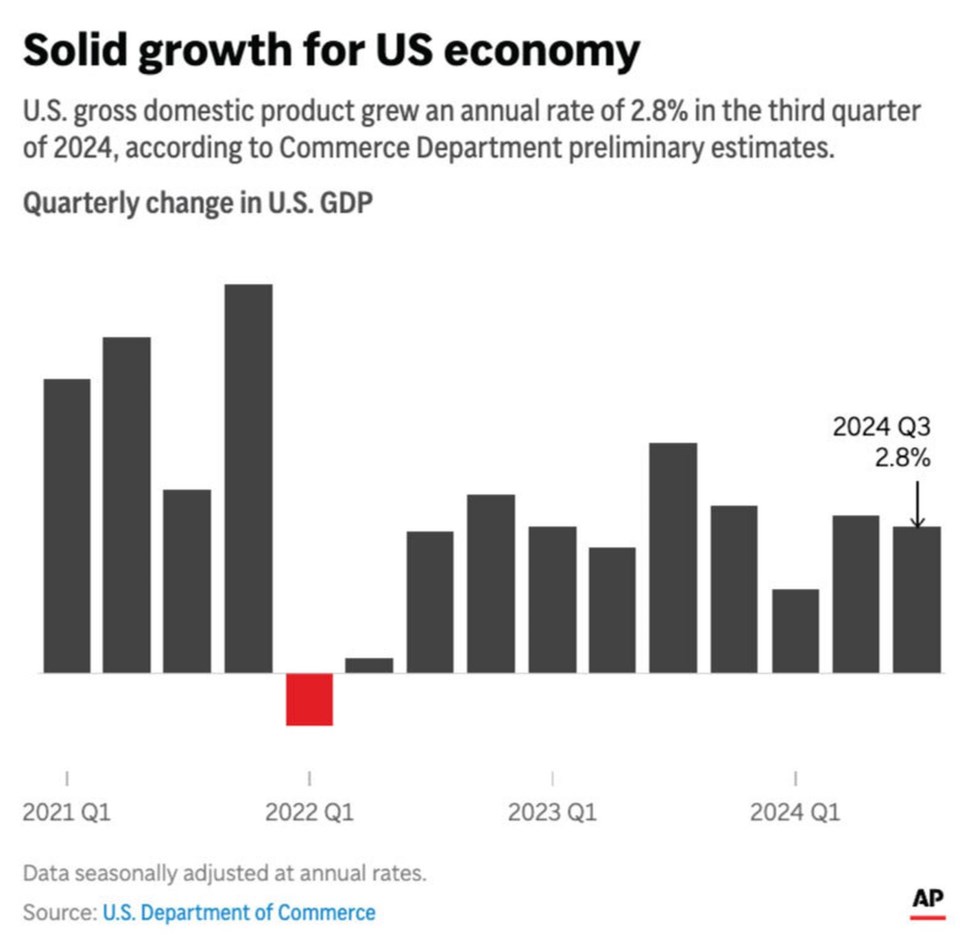WASHINGTON (AP) — The U.S. economy grew at a healthy 2.8% annual rate from July through September, with consumers helping drive growth despite the weight of still-high interest rates.
Wednesday’s report from the Commerce Department said the gross domestic product — the economy’s total output of goods and services — did slow slightly from its 3% growth rate in the April-June quarter. But the latest figures still reflect surprising durability just as Americans in the final stretch of the presidential race.
Consumer spending, which accounts for about 70% of U.S. economic activity, accelerated to a 3.7% annual pace last quarter, up from 2.8% in the April-June period. Exports also contributed to the third quarter's growth, increasing at an 8.9% rate.
On the other hand, growth in business investment slowed sharply on a drop in investment in housing and in nonresidential buildings such as offices and warehouses. But spending on equipment surged.
Wednesday’s report also contained some encouraging news on inflation. The Federal Reserve's favored inflation gauge — called the personal consumption expenditures index, or PCE — rose at just a 1.5% annual pace last quarter, down from 2.5% in the second quarter and the lowest figure in more than four years. Excluding volatile food and energy prices, so-called core PCE inflation was 2.2%, down from 2.8% in the April-June quarter.
The report is the first of three estimates the government will make of GDP growth for the third quarter of the year. The U.S. economy has continued to expand in the face of the the Fed imposed in 2022 and 2023 in its drive to curb the inflation that surged as the United States bounced back with unexpected strength from the brief but devastating COVID-19 recession of 2020. Despite widespread predictions that the economy would succumb to a recession, it has kept growing, with employers still hiring and consumers still spending. And with inflation steadily cooling, the Fed has begun to cut interest rates.
The report “sends a clear message that the economy is doing well, and inflation is moderating — good news for the Federal Reserve,’’ said Ryan Sweet, chief U.S. economist at Oxford Economics.
Within the GDP data, a category that measures the economy’s underlying strength rose at a solid 3.2% annual rate from July through September, up from 2.7% in the April-June quarter. This category includes consumer spending and private investment but excludes volatile items like exports, inventories and government spending.
"Today’s GDP report shows how far we’ve come since I took office—from the worst economic crisis since the Great Depression to the strongest economy in the world,'' President Joe Biden said.
Other recent economic reports have also pointed to a still-healthy economy. In a sign that the nation’s households, whose purchases drive most of the economy, will continue spending, the Conference Board said Tuesday that its posted its biggest monthly gain since March 2021. The proportion of consumers who expect a recession in the next 12 months dropped to its lowest point since the board first posed that question in July 2022.
At the same time, the nation’s once-sizzling job market has lost some momentum. On Tuesday, the government reported that the number of job openings in the United States fell in September to . And employers have added an average of 200,000 jobs a month so far this year — a healthy number but down from a record 604,000 in 2021 as the economy rebounded from the pandemic recession, 377,000 in 2022 and 251,000 in 2023.
On Friday, the Labor Department is expected to report that the economy added 120,000 jobs in October. That gain, though, will probably have been significantly held down by the effects of Hurricanes Helene and Milton and by a strike at Boeing, the aviation giant, all of which temporarily knocked thousands of people off payrolls.
Despite the continued progress on inflation, average prices still far exceed their pre-pandemic levels, which has exasperated many Americans and posed a challenge to Vice President Kamala Harris’ prospects in her race against former President Donald Trump. Most mainstream economists have suggested, though, that Trump’s policy proposals, unlike Harris’, .
At its most recent meeting last month, the Fed was satisfied enough with its progress against inflation — and concerned enough by the slowing job market — to slash its benchmark rate by , its first and largest rate cut in more than four years. When it meets next week, the Fed is expected to announce another rate cut, this one by a more typical quarter-point.
The central bank’s policymakers have also signaled that they expect to cut their key rate again at their final two meetings this year, in November and December. And they envision four more rate cuts in 2025 and two in 2026. The cumulative result of the Fed’s rate cuts, over time, will likely be lower borrowing rates for consumers and businesses.
Paul Wiseman, The Associated Press



